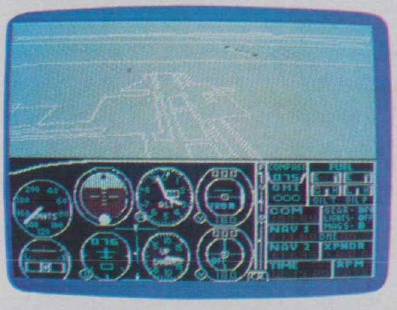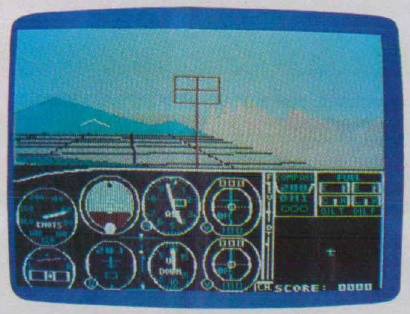Microsoft Flight Simulator For PC & PCjr
David Florance, Programming Assistant
Requirements: IBM PC with at least 64K RAM, one disk drive, and color/graphics adapter (optional Microsoft Mouse requires 128K RAM); or PCjr with at least 128K RAM and one disk drive. Joystick optional.
Commercial flight simulators were developed for one very good reason: Airplanes cost a great deal of money. When a student learning to fly makes a mistake, it's better for the mistake to happen in a flight simulator safe on the ground than to lose an entire aircraft (not to mention the trainee pilot).
Several software companies have recently adapted flight simulators to personal computers. You can't expect to use these programs to qualify for a pilot's license, but they're both fun and educational.
Microsoft Flight Simulator, by Bruce A. Artwick of SubLogic, is one of the best. For most of the last year it's been a top-selling program for the IBM PC and compatibles. The latest version sports two major improvements: It runs on both the PC and PCjr, and it generates a color display on direct-drive RGB monitors. Earlier versions depended upon artifacting (false high-resolution colors) to create color displays. This was fine if you plugged your PC into a composite color monitor or TV set. But everything appeared in black and white on RGB monitors because they're capable of resolving adjacent hi-res pixels without the artifacting effect. The new version of the program generates true colors on both types of displays.
Before you try Microsoft Flight Simulator, however, be forewarned—if you don't know much about flying, this program may overwhelm you. It's not a simple simulation. It's a challenging program even for experienced pilots. Your first step should be to read the 149-page manual, packed with diagrams, maps, runway layouts for dozens of airports, an appendix describing your plane's performance specs, an airport directory, a glossary of aviation terms, and an index. The manual explains how to fly the aircraft with either the keyboard or a joystick, plus a great many more details.

Changing The Weather
Before you take off, read the section that explains how an aircraft operates. Once you know a bit about flying, you'll be better prepared to enjoy (and understand) Microsoft Flight Simulator. Even if you've done some flying, you'll benefit by reading the manual.
Next, if you're using a PCjr, you should become familiar with the keyboard overlay. If you have a PC, you'll have to work without an overlay, so carefully study the section on aircraft controls. It explains the various instruments you'll be working with. These instruments should be constantly monitored during flight because they indicate your airspeed, attitude, altitude, heading, and throttle at a glance.

With any program requiring sharp hand-eye coordination, practice makes perfect. But it's especially critical with Microsoft Flight Simulator. When using the keyboard controls, keep the manual in a strategic location for easy reference. As you improve your flying skills, you'll learn how to use navigational aids such as the VOR, the ADF, the NAV 1, NAV 2, and COM radios. You can use the 3-D display window to look around you from nine different perspectives. Finally, there is the radar view, which is indispensable when taxiing on the runways.
With the program's Editor feature, you can redefine current flight parameters. The User Mode Library gives you ten preset modes plus options to save and load player-defined modes. You can use the Editor to set cloud layers, wind factors, seasons, and even the time of day. Say, for instance, you want to work on landing skills. You would, call the Editor, set the flight parameters for a landing approach, save it in the Library, and reenter the flight mode.
Until you gain a working knowledge of the instruments, you'll have trouble making successful flights. You won't fly far if you haven't practiced banks and yaws, or use of the elevators. You'll sometimes crash, but don't be discouraged when it happens.
Four Regions And A War
Microsoft Flight Simulator lets you choose to fly from Chicago, New York, Los Angeles, or Seattle. Numerous airports are available for landings, and—as in real life—not all are identically equipped. Larger airports have more sophisticated equipment. There are hours of exploration within each region.
Flying from one region to another is possible, too, but it may take four or five hours. Slewing, or exponential travel, is an alternative to realtime flying. It allows you to rapidly travel great distances in little time.
In addition to the four regions available for civilian flight, there's also a fifth simulation—World War I Ace, a game which places you in Europe in 1917.
Controls Are Sensitive
Microsoft Flight Simulator is interesting, challenging, graphically superb, diverse, rewarding, and just plain fun. And the documentation is great. In terms of realism, it sets the standards.
There are two slight drawbacks. The instruments in Microsoft Flight Simulator are more delicate than on real aircraft. There are legitimate arguments that this is the way a flight simulator should respond; it trains you to develop even more skill than flying a real plane would require. But others would prefer to see more realistic controls which respond exactly like the real thing.
The other weakness is an obvious one that applies to all personal computer flight simulators: the absence of rudder pedals and similar controls. Controlling the aircraft with keys or a joystick may befuddle pilots who are used to real controls.
Still, these shortcomings are easily outweighed by the sheer delight this program brings.
Microsoft Flight Simulator
Microsoft, Inc.
10700 Northrup Way
Box 97200
Belleview, WA 98009
$49.95